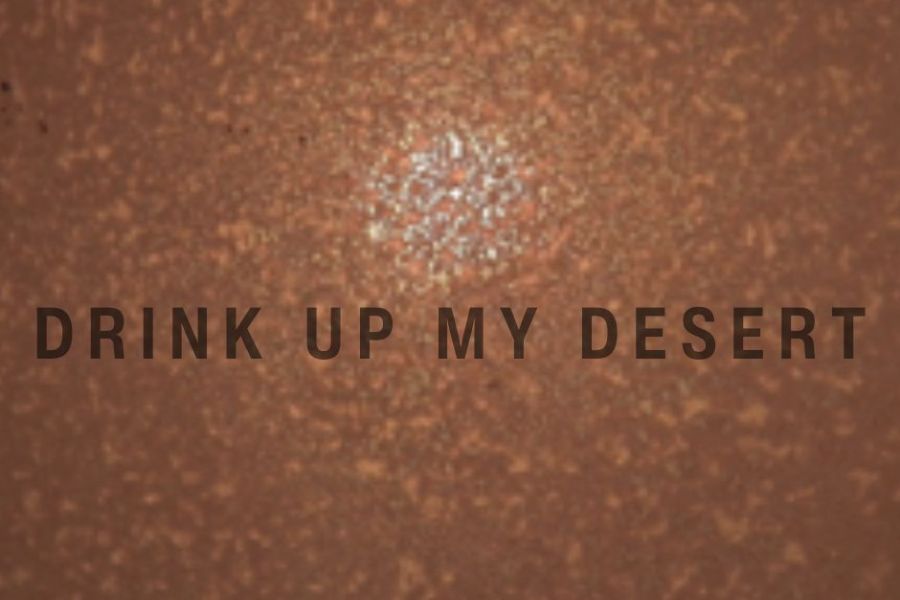DRINK UP MY DESERT

Index of temporary surfaces
-notes to the exhibition “Drink up my desert” by Andreas Brunner
Mia Ćuk
Standing there on the embankment, staring into the current, I realised that— in spite of all the risks involved— a thing in motion will always be better than a thing at rest; that change will always be a nobler thing than permanence; that that which is static will degenerate and decay, turn to ash, while that which is in motion is able to last for all eternity.
– Olga Tokarczuk, Flights
Oh Michael! Every joy is like the manna[1] the desert which corrupts from one day to the next; It is like the fountain of Ameles, whose waters, says Plato, could never be kept in a vase…
– Marc Camille Chaimowicz, Café du Rêve
The body of artwork in front of me would hardly be possible to discuss if one attempted to do so by way of direct theoretical confrontation. The logic of “flowing disconnectedness” renders the pieces both akin to and disjoint from a fixed narrative centre, that no strict common ground (or, in fact, any ground) should be looked for; instead, what is proposed is that one lets her mind drift downstream focusing on the passing landscapes of free associations, recollections and mental images that draw up one possible version of this exhibition.
***
The cluster of loose fragments comprises natural and social structures transcribed into sentiments of particular cultural topoi that generate a highly idiosyncratic semantic space. The poetic tone set by the title “Drink up my desert” suggests a paradox that continues to reverberate through the materiality of the produced works, whereby states of matter become intense metaphors for symptomatic places (malaises, conditions, syndromes) of our ever more volatile realities.
It is perhaps suggestive that I am looking at the pieces on the bland surface of my 13-inch laptop screen which renders them deceitfully even and dry, making me ponder over again about the state of matter of an LCD screen whose strange amorphous properties invoke an image of alchemical transmutations: Liquid crystal (LC) is a state of matter whose properties are between those of conventional liquids and those of solid crystals. For example, a liquid crystal can flow like a liquid, but its molecules may be oriented in a common direction as in a solid.
We live in an age where technological advancements have made it possible for poetic metaphors to become literal prospects.
***
Looking at the exhibition material sent to me via email, I have penned down the following notes and phrases that came up intuitively, forming a loose rhizomatic mood board that resists steady classification:
visceral structures
emotions, moods, behaviours in terms of their humidity level
such as
longing is moist but not liquid
depression is semi-dry, powdery
poetics of matter and antimatter
the distance, always gazed never precisely calculated
metrics of fading
atmosphere–dust, pollen, air pollution–obscure or lighten?
Vitruvian superimpositions,
modernist surface, geographical entities and the human body
x-rays’ influence on architectural drawing
longing triggered by maps and scale models
opaqueness and transparency
bones of mammals as measurement units
not talismans or charms
futile attempts at return
(return in relation to homecoming in relation to rivers)
return having no state of matter
I keep thinking about the writing mode that could reflect this contingency of the matter that seems to figure constantly in the pulse of the works, the alchemic, sfumato, non-linear and malleable writing; writing not about but around and within.
If it is true that a sensibility (as distinct from an idea) is one of the hardest things to talk about,[2] then it must be so because a sensibility (unlike an idea) is conjured out of seemingly nothing in particular, fugitive sensations. Sensibility is a kind of emotional scenography to ideas. Yet its evocative powers surpass those of fixed notions and worked-out concepts that always strike as all too resolved. I come to realise that what interests me in this group of artworks is precisely the ambiguous scaffolding of preferences, frequencies and temperaments that compose a certain transcendental “something”, an aura or a shimmer of an object which signalises its belonging to a particular aesthetical register at once deeply foreign and familiar to me.
Like a magnet, sensibility draws things that are just enough strange to be akin to it:
The Last Homecoming
I have returned there
where I had never been.
Nothing has changed from how it was not.
On the table (on the chequered
tablecloth) half full
I found again the glass
never filled. All
has remained just as
I had never left it.
– Giorgio Caproni
[1]Manna (Hebrew: מָן, Greek: μάννα; Arabic: اَلْمَنُّ), sometimes or archaically spelled mana, is described in the Bible and the Quran as an edible substance that God bestowed upon the Israelites while they were wandering the desert during the 40-year period that followed the Exodus and preceded the conquest of Canaan. In the description in the Book of Exodus, manna is described as being “a fine, flake-like thing” like the frost on the ground. It is described in the Book of Numbers as arriving with the dew during the night. Exodus adds that it had to be collected before it was melted by the heat of the Sun, and that it was like a coriander seed in size, but white in colour.
[2]Notes on Camp, Susan Sontag, Partisan Review, 1964.
Photo: N. Ivanović
